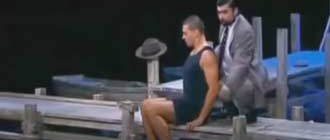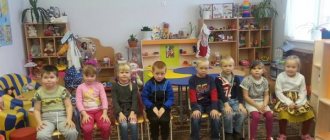On the topic: methodological developments, presentations and notes
1. Clarify the idea of vegetables.2. Expand and activate vocabulary on the topic.3. Improve the grammatical structure of speech.4. Develop phonemic awareness.5. Develop coherent speech, spectator.
Organizing an excursion to the garden for children of primary preschool age.
Summary of the excursion “Vegetables”, “Vegetable Garden”, senior preschool age. Consolidation and expansion of ideas about vegetables, about seasonal changes in the life of plants, about the preparation of vegetables for.
Source
Excursion to the vegetable garden “Visiting the Red Summer”
Svetlana Grinina
Excursion to the vegetable garden “Visiting the Red Summer”
Goal: Continue to develop children’s ideas about seasonal work in the garden .
Educational: to develop children’s skills in caring for plants;
Speech: activate children's vocabulary (harvest, row spacing, weeds, weeding, root crops, equipment)
; learn to answer questions in complete sentences;
Developmental: develop children's logical thinking and imagination;
Educational: to cultivate love for the native land, the need for work, the desire for meaningful results.
Material: set of illustrations “Vegetables”
;
a set of tools for working in the garden ;
sticks for loosening the soil; apple. Preliminary work: Conversations about seasonal work in the garden ; looking at illustrations “Vegetables”
;
didactic game “Tops - Roots”
;
learning poems and riddles about vegetables; teacher's story about gardening equipment ; didactic game “What is needed for a vegetable garden ?”
Summary of the walk in the senior group “Visiting the trees”
Target:
creating conditions for the formation of cognitive and research knowledge and skills of children.
Tasks:
Educational
- Learn to reason, draw conclusions about certain patterns and relationships in nature.
- Teach children to use the simplest methods of examining trees.
- Teach you to see the beauty of the world around you.
Developmental
- Develop interest and concern for the plant world.
- Develop children's speech and creative abilities.
- Develop dexterity when performing movements, speed, endurance.
Educational
- Cultivate a caring attitude towards wood as a living object.
Integration of educational areas
Cognitive, speech, social-communicative, physical, artistic and aesthetic development.
Equipment
Magnifying glasses for each child, “sun”, “drop”, “bird”, “leaves”, soil, skittles, balls, target.
Progress of the walk
Cognitive and research activities
Educator:
Today I want to invite you to a meeting with nature, its secrets and surprises.
Wise nature teaches us at any time of the year.
Birds teach singing. A spider of patience.
Bees in the field and in the garden teach us how to work.
Snow teaches us purity, the sun teaches us kindness.
You need to learn from nature all year round.
All forest people teach strong friendship.
Are you wondering what lies ahead and what nature can teach us today?
Children:
Yes, we are very interested.
Weather observation
Educator: Children,
what's your mood? (children's answers)
Let’s try to determine together what mood the weather is in. Look what the sky is like? Tell us about it. Does the sun make us happy? What is it like? Is there any wind today? How did you find out?
Generalization: Clouds are floating across the sky, each one may seem something unusual to us. A light breeze sways the tree branches, sharing its secrets. The bright sun is our companion and friend. Let nothing darken our mood today. We will be glad to see any meetings.
And here is our first meeting. Pay attention to the variety of trees in and around the kindergarten site.
Educator:
Who can tell what trees grow on the site?
Children:
Poplars, maples, chestnuts, and linden trees grow on our site.
Educator:
By what signs were you able to determine the name of the trees?
Children:
All trees have different leaf shapes and bark colors.
The teacher pays attention to the conditions in which some specimens are located (shade, the presence of a fence or wall that interferes with the growth of plants) Compare with trees that grow on the sunny side. Identify differences in the crown, bark of trees, location of branches.)
Educator:
Children, now we will go to visit another tree, and which one you will find out when you guess the riddle.
White-trunked beauties
We stood together by the path,
The branches go down to the bottom,
And there are earrings on the branches.
What tree is this riddle about?
Children:
About the birch tree, they grow in a kindergarten near the playground.
Educator:
That's right, this is a birch tree, it is especially dear to our people. Why do you think it is called white-trunked?
Children:
Birch is called white-trunked because it has a white trunk.
Educator:
Yes, indeed, the birch tree has a slender, tall, white trunk with black spots. In Russian folk tales and songs it is called “white-trunked”.
And now I suggest you take a magnifying glass and carefully examine the birch bark.
(Children, together with the teacher, look at the bark of trees and talk about what they observe)
Educator:
Children, do you think trees have friends? Who are they?
(Children's answers)
Would you like to make friends with trees? Do you know how to do this? (Children’s thoughts) Now I’ll show you. I want to make friends with this birch tree. I will stroke her bark, press my cheek to her, hug her. You can also read her a poem.
White birch, pure birch,
Always cheerful, always radiant.
The branches reach out to warmth and light,
Spring and summer always smiles.
And now you, children, choose a tree for yourself and make friends with it.
People say: if you hug a tree, it will give you strength and health.
Game “Run to the Named Tree”
Didactic task
Find a tree by name
Game action
Run to the named tree. (Competition “Who can find the tree fastest”)
Rule:
You can run to the named tree only with the command “Run!”
Progress of the game:
The teacher names a tree that is well known to the children and has bright distinctive features, for example: “One, two, three - run to the birch!”
Children must find a tree and quickly run to any birch tree growing in the area where the game is being played. At the end of the game, the teacher says: “One, two, three - run to me!”
Trees are the decoration of our Earth,
Ants and nightingales cannot live without them,
Neither animals, nor berries, nor mushrooms,
Neither people, nor birds, nor elephants.
Educator:
How do trees benefit people?
Children:
Trees give us oxygen so we can breathe.
Educator:
Yes, indeed, trees give us oxygen so that we can breathe, therefore live, and for this we must love and thank them.
Trees are necessary not only for humans. Who else do you think needs trees?
Children:
Birds need trees.
Educator:
A tree is a kind of house in which different residents live. Who do you think can live on a birch tree?
Children:
Birds and insects can live on a birch tree.
(Children take magnifying glasses and look for various insects on the birch trunk, in the cracks)
Educator:
For residents, wood is not only a home, but also a dining room
.
Why do you think?
Children:
Birds eat various insects.
Educator:
Yes, you are right, birds eat insects, and they also find seeds and fruits of trees. And insects - plant food and the larvae of other insects.
Children, do you like receiving gifts? (Children's answers)
Do you like to give gifts yourself? (Children's answers)
Let's give gifts to the birch tree.
Children:
I give you the sun, let it shine brightly, brightly and warm you.
I give you a drop of water, let it drink and wash you.
I give you a bird, it will be your friend and save you from the caterpillars.
I give you green leaves, may you always have many, many of them, they will make noise, I will come to listen to the noise and hide under it from the bright sun.
I give you land - soil so that you can grow better, let it feed and water you.
Educator:
The best gift for a birch tree and its friends will be our care and attention. How can we help the birch tree?
Children:
We can water it without tearing branches and leaves from it.
Work
Target:
To develop diligence, develop the desire to work together, and cultivate a sense of beauty.
Educator:
Yes, of course, we can water it without hurting it. And now I suggest you level the holes near the birches, pull out the grass and water them.
There is a popular proverb: “It takes a second to break a tree, but it takes years to grow it.”
How do you understand this proverb?
Educator:
Children, you are all great, you helped the trees. And now I invite you to play the outdoor game “Take a Seat”
Outdoor game "Take a seat"
Target:
Develop children's physical activity. Develop agility, speed, spatial orientation.
One of the participants in the game is chosen as the driver according to the counting rhyme
One two three four five
We can't count our friends
And life is hard without a friend,
Get out of the circle quickly.
The rest of the players, forming a circle, walk holding hands. The driver follows the circle in the opposite direction and says:
I chirp like a magpie.
I won't let anyone into the house.
I cackle like a goose,
I'll slap you on the shoulder -
Run!
Having said “run”, the driver touches the back of one of the players, the circle stops, and the one who was hit. He rushes from his place in a circle, towards the driver. The one who runs around the circle first takes a free place, and the remaining one becomes the driver.
Rules of the game:
the circle should immediately stop when the word “run” is said. You are only allowed to run in a circle without crossing it. While running, you must not touch those standing in a circle.
Independent motor play activity of children.
- Climbing on a gymnastic ladder (Do not jump from the upper level)
Target:
strengthen the ability to climb gymnastic stairs.
- Game “Dead Eye” (A target is hung at the child’s eye level, a line is drawn at a distance of 2-3 meters from the target, and children from this line throw a small ball at the target, trying to hit it.)
Target:
Develop precision of movement and eye.
Game-exercise for hyperactive children “Swipe the ball”
Exercise game for sedentary children “Quickly pass the ball”
Target:
development of dexterity and coordination of movement.



